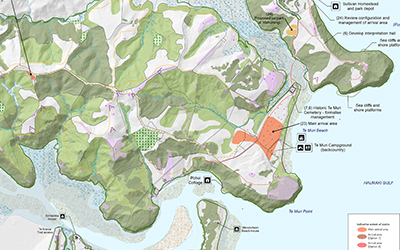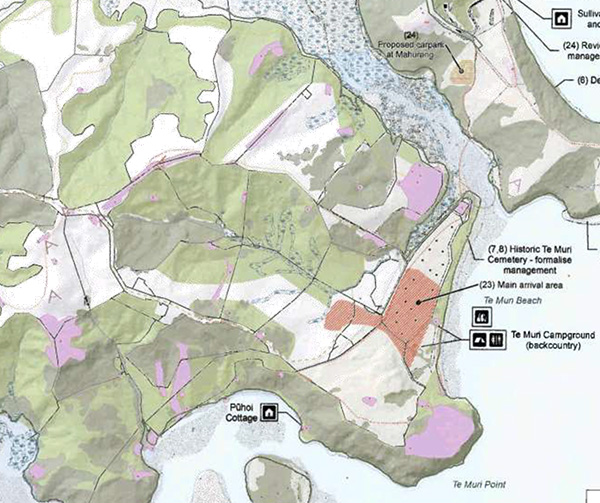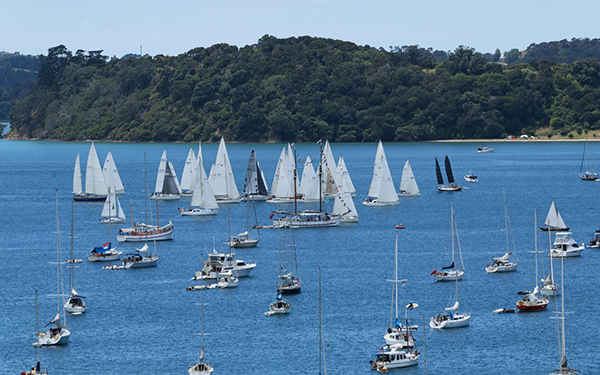Share Te Muri with walking Aucklanders or their cars


Stark as They Are Simple: Development choices for Te Muri are between road access, after the Pūhoi–Warkworth motorway is constructed, and parking for thousands of cars near the beach, or the Mahurangi Coastal Trail, and every ingenious ploy possible deployed to encourage appropriate use of the 383-hectare Schischka farm as more than just a $20 million driveway to Te Muri Beach. map Auckland Council
It’s been timed for low tide that day, at 12.22 pm. Because, despite the Auckland Regional Authority’s citizens advisory group 29 years ago embracing the concept of developing Te Muri for walking access only, there’s still no all-tide access across the estuary from Mahurangi West.
Some, of course, do not want all-tide access, nor any development that would see one additional person visiting their special place. Others, particularly those who heroically headed off the regional authority’s plans to build a concrete road bridge across Te Muri Estuary and to provide parking for 4000 cars behind the beach, knew that improved walking access was the only long-term alternative to the area being opened up by that much more disruptive option.
Fast-forward to 2010. On the eve of the regional amalgamation, the 383as published: 407-hectare Schischka farm was the last regional park purchase by the regional council. While proponents of regional parks rejoiced at the acquisition, those who had seen-off the road access plans in 1987 knew, even before reading past the headlines, with $15 million having been invested to take pressure off Wenderholm and Sullivans Bay, Te Muri was not going to be allowed to continue to receive so few visitors that it might as well still be in private ownership. It brought into sharp relief that the only long-term hope for keeping Te Muri car-free was if the long-mooted Mahurangi Coastal Trail was belatedly developed, and that it proved to provide sufficient access to result in the new regional parkland being appreciably used.
So rather than delight at the development, those who understood the implications felt a chill when reading that:
The new park, including access to Te Muri Bay, will now be accessible by Hungry Creek Rd.
In the mainstream media coverage of the purchase, no mention was made of the hard-fought campaign of 1987, much less the potential of a Mahurangi Coastal Trail to provide reasonable access for those willing to invest a little effort to reach ‘Auckland’s New Chums.’
Of the 88 submissions that were made during the first phase of consultation via the Mahurangi Magazine, and in the current, formal phase, and the 77 hardcopy submissions that were made at the Mahurangi Regatta alone, all favour the Mahurangi Coastal Trail concept. Only two of the total of 140 phase-one submissions called for car access. While it might not particularly harm the case against car access to also oppose greater foot access, the experience both 29 years ago and this time around is that council officers and politicians simply categorise such views as nimbyism, particularly with the region’s population projected to increase by one million over the next 30 years. That, and the present lack of any policy or appetite for maintaining the rate of regional park acquisitions achieved during the last 50 years, it is indefensible to do nothing to allow more Aucklanders to enjoy regional parkland purchased for their enjoyment. But, aside from the right of reasonable access to Auckland Regional Parks, walking the coastline is a primeval human instinct, and if New Zealanders had an ounce of respect for the whenua they would be able to traverse the entire coastal margin of their motu unchallenged. Instead, billions are spent on infrastructure for more and more climate-disrupting motor vehicles. At present those able to enjoy Te Muri typically access via car from Mahurangi West, or by petrol-powered boat from Wenderholm and boat ramps farther afield, or by kayak—the latter two modes generally also following a car trip. Public transport and walking, with their myriad, well documented health benefits are at the bottom of the heap. For a fifth of the estimated cost of upgrading Hungry Creek Road and the Schischka farm road, the entire Mahurangi Coastal Trail could be developed, complete with the low-key Judge Arnold Turner Footbridge and opening span, which would allow even the venerable and busty Jane Gifford to venture up the Pūhoi River.

Allowing for the Scow: Lest anyone be concerned that the Mahurangi Coastal Trail’s proposed Judge Arnold Turner Footbridge might impede navigation of the Pūhoi River, it would have an opening span sufficient to easily allow beamy craft such as the Jane Gifford to venture upstream—at least as far as the State Highway 1 road bridge permits her to. Pictured, the Jane Gifford performing her role as the Mahurangi Regatta flagship during the start of the modern classics race, 2016. image What You See Photography Jill Guillemin
Those who fancy they can beat into submission the three appointed commissioners whose job it will be to consider the current round of input—with the position that it shouldn’t be made easier for folk to access Te Muri—would do well to reflect that without the community’s proposal for developing Te Muri for walking access only, access for these last 29 years would have been by road bridge across Te Muri Estuary into a 2000-car parking area behind the beach. The walking access was never improved because regional parks management of the day wanted to prove that few people would visit Te Muri without road access. Mahurangi Action, at almost every opportunity, continued to advocate for improved foot access knowing that, without it, the regional council’s preoccupation with road access would never go away—at least, so long as the private car reigns supreme.
Ultimately, it is unconscionable that only the car-owning classes that can access Te Muri. The poor and the deliberately carless should be able to get off the bus at Waiwera and walk as far as they care to into the greater 900-hectare Mahurangi regional park estate. Many regional parks are too far-flung to be accessed, in the near future, by public transport, but Mahurangi, Te Muri and Wenderholm are ripe for connection. Meantime, those who with every justification consider that the wellbeing of Te Muri’s dotterels, oystercatchers and shearwaters should have supremacy over human access should note that Mahurangi Action’s proposed route for the coastal trail avoids the particularly sensitive area—the sandspit—altogether, and would significantly reduce anthropogenic disturbance below that which is currently occurring, as people blithely paddle or wade across the estuary, and file past or through that vulnerable, crucial breeding area.
Something to think about when walking in to Auckland Council’s ‘walk-in open day’ on the draft management plan variation, on Saturday 20 February.
Te Muri Crossing timeline
- 1965
- Wenderholm Regional Park acquired – first acquired by then new regional council
- 1973
- Coastal margin of Te Muri acquired – under the Public Works Act
- 1974
- Mahurangi Action established, as Friends of the Mahurangi Incorporated
- 1986
- Geotechnical investigation for planned road bridge across Te Muri Estuary
- 1987
- Suggestions for Te Muri access to citizens advisory group – by Mahurangi West and Pukapuka Residents and Ratepayers Association
- 1987
- Submission on draft management plan, including Mahurangi coastal trail as opposed to the proposed road from Ngārewa Drive, Mahurangi West
- 2010
- 383-hectare Te Muri hinterland acquired – resurrection of road access to beach
- 2010
- Auckland Regional Council subsumed by new, regional Auckland Council
- 2014
- Mahurangi Coastal Trail technical document for discussion – Mahurangi Action Incorporated
- 2015
- Phase-1 of Te Muri variation to regional parks management plan – 140 submitters
- 2015
- Mahurangi Coastal Trail Trust established by Mahurangi Action and Friends of Regional Parks
- 2016
- Phase-2 of Te Muri variation – further 383 submissions. All but a handful of 523 in total received oppose private-light-vehicle access to Te Muri Beach
- 2016
- No private-light-vehicle access to Te Muri Beach – resolution by Auckland Council
- 2019
- Memorandum of understanding between Auckland Council and Mahurangi Action to develop Te Muri Crossing and Mahurangi Coastal Trail
- 2020
- Davis Coastal Consultants retained by Mahurangi Coastal Trail Trust to design and seek resource consent for Te Muri Crossing
- 2020
- Phase-1 Regional Parks Management Plan Review submissions
- 2020
- With Ngāti Manuhiri, preferred route for Te Muri Crossing identified
- 2021
- First presentation of Te Muri Crossing design process – 30 May, tickets $80, free tickets offered
- 2021
- Coffee-and-croissants drop-in day at Mahurangi West Hall 3 July – free
- 2021
- Draft Regional Parks Management Plan due for release and call for submissions – target dates yet to be disclosed
